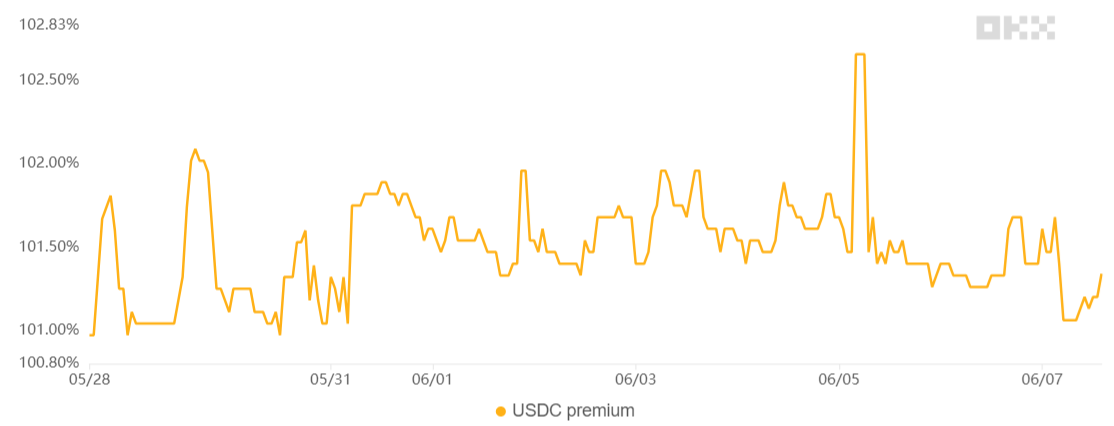
Bitcoin (BTC) briefly approached the $72,000 resistance level on June 7, but its intraday gains quickly evaporated, sending the cryptocurrency plunging to $69,000. Even more worrying, two indicators, including a long and short measure of major stock traders, suggest that Bitcoin investors are becoming less optimistic. Is the Bitcoin bull market over, at least in the short term?
Bitcoin and Gold Trade Lower Amid S&P 500 All-Time High
The S&P 500 hit a new intraday record on June 7 after the United States reported an increase of 272,000 nonfarm jobs in May, far surpassing the previous month’s figure of 165,000 jobs. A strong labor market is generally beneficial for credit and consumption, and therefore for listed companies. People are more likely to spend when the labor market is flexible, regardless of the cost of capital.
The relationship between job creation and business profits is considered particularly favorable, especially since the U.S. Bureau of Labor Statistics reported that wages increased 0.4% in May from the previous month , with the participation of prime-age workers, between 25 and 25 years old. and 54, reaching their peak. The highest level in 22 years, 83.6%. Even though U.S. consumer stocks fell today, the technology sector more than offset the move.
Robert Sokin, chief economist at Citi, noted that the longer the U.S. Federal Reserve keeps interest rates above 5.25%, the greater the risk of recession, as reported by Yahoo Finance. However, there are no signs of imminent danger based on the latest unemployment data in the United States, which stands at 4%. According to the CME FedWatch tool, investors currently expect a 51% chance that the Fed will cut interest rates by September, up from 69% the day before.
Bitcoin is not the only asset class to be negatively affected by macroeconomic data and lower investor expectations for falling interest rates. Gold fell to $2,300 after flirting with $2,390 in the early hours of June 7. Similarly, the two-year U.S. Treasury yield jumped from 4.74% to 4.87% over the same period, suggesting traders are offloading their bond positions.
While it may seem inconsistent that Bitcoin is trading lower after gold and fixed income while the stock market is decoupled, one must keep in mind that the largest U.S.-listed companies United collectively holds $3.6 trillion in cash and cash equivalents. These holdings can either generate returns in the money market or be deployed in share buyback programs. Crucially, even if corporate profits are affected, the impact on prices will be much less than that of other assets.
Top Bitcoin traders recently reduced their bullish bets
To understand whether whale sentiment was affected by the rejection of the $72,000 price resistance, one needs to analyze data from Bitcoin futures markets. Traders’ long/short ratio consolidates positions in spot, perpetual and monthly futures contracts. A higher ratio favors long (buy) positions, while the opposite indicates that professional traders prefer short (sell) contracts.
On Binance, the current buy/sell ratio is 1.35, a less optimistic position compared to the previous week of May 31, when the indicator was 1.58, favoring long trades. Likewise, senior traders on OKX are now less optimistic than on May 31, with the buy/sell ratio falling from 1.79 to 1.22. On average, the index fell to its lowest level in over two weeks, which is somewhat worrying, but still favors bullish bets in absolute terms.
However, other indicators, such as China’s stable premium, show a slight increase in demand from retail traders. Excessive retail flow typically sends the stablecoin premium above 1.5%, while bear markets result in a discount.

The USDC premium in China has maintained levels just above the neutral threshold of 1%, completely ignoring the Bitcoin price correction on June 7. From one perspective, bulls can take comfort in knowing that whales and retail traders are not panic selling. Data like this supports the idea that long- and short-term interest rates for major Bitcoin traders could eventually improve as the $69,000 support shows strength.
This article is intended for general information purposes and is not intended and should not be relied upon as legal or investment advice. The views, thoughts and opinions expressed herein are those of the author alone and do not necessarily reflect or represent the views and opinions of Cointelegraph.